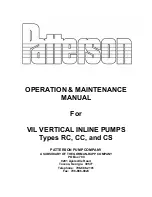
English
Installation and operating instructions Wilo-COR..MHIE.../MS
9
The water supply to the pressure-boosting sys
-
tem may be taken from the municipal water sup
-
ply or from a replenishment reservoir.
Automatic control pressure-boosting systems
supplied from the public drinking water mains are
either directly (direct connection) or indirectly
(indirect connection) fed via a break tank. These
break tanks are closed and not pressurised, i.e.
they are not pressurised atmospherically.
5 Technical information
5.1 Type key
5.2 Technical data
• Max. operating pressure:
10 bar
• Permissible fluid temperature:
from 3 to 50 °C
• Permissible ambient temperature: from 5 to 40 °C
• Supply voltage:
3~ 400 V ±10 %
• Frequency:
50 or 60 Hz
Ensure that the general installation complies with
safety standard NF-C 15-100.
5.3 Delivery
It is crucial, prior to installation, to be aware of all
main components that make up the pressure-
boosting system.
See the pressure-boosting system illustration in
Fig. 1:
1. Switchgear and protection control
2. Integrated frequency converter to control the
speed of the MHIE pump
3. MHIE variable-speed horizontal pump
4. Suction manifold
5. Discharge manifold
6. Pressure sensor
7. Baseplate for support and fixation
8. Pressure gauge
9. Pressure tank
NOTICE:
Each pump is equipped with suction-side gate
valves, non-return valves and discharge valves.
See the control card illustration in Fig. 2 & 3:
1. Electronic control card
2. Integrated frequency converter to control the
speed of the MHIE pump
3. Switch for selecting the number of pumps
4. Adjustable resistor
5. Adhesive supports
5.4 Accessories
The following accessories are available for
purchase:
• Gate valves
• Vibration damping hoses
• Pressure reducer
• Pressure tank
• Foot valve strainer
Accessories must be ordered separately and must
be installed on the system.
6 Description and function
6.1 Description
The pressure-boosting system is supplied with its
pipework ready for connection. The customer
must connect the suction and discharge manifolds
correctly.
The customer must also connect the switchgear
to the mains power supply.
When making the connection to the municipal
water supply, regulations and currently valid
standards must be observed and, as necessary,
fulfilled pursuant to the regulations of water dis
-
tribution companies.
In addition, local specificities must be taken into
account: for example, if the suction pressure is too
high or variable, a pressure reducer must be
installed.
6.2 Operation
The pressure-boosting system is equipped with
non self-priming high-pressure multistage cen
-
trifugal pumps.
The pumps increase the pressure and transport
the water to the consumer by means of the dis
-
charge manifold. In addition, they are activated/
deactivated or controlled according to the pres
-
sure rating. Due to the pressure sensor, the actual
pressure rating value is continuously measured,
converted into a current signal and then transmit
-
ted to the control card.
The pumps are activated, added and deactivated
as required by means of the control card. A pump’s
speed is modified up to the point at which the set
control parameters are reached.
The pump initiated first is called the main pump.
All the other pumps required for reaching the sys
-
tem’s duty point are called peak-load pumps. To
configure the drinking water supply system
according to DIN 1988, a standby pump must be
provided, so that there is always a pump on
standby in the event of max. circulation. In order
to ensure balanced operation of all the pumps,
constant controlled duty cycling of the pumps
takes place, i.e. the commissioning sequence and
the deployment of the primary load, topping-up
and standby pump functions change regularly.
The control card enables automatic duty cycling
around every 200 minutes in order to distribute
the operation hours for each pump.
COR-3 MHIE 403/MS
COR
Name of pressure-boosting system
3
Number of pumps
MHIE
Pump type
403
Rated flow rate and number of stages
(4 m³/h, 3 stages)
MS
Operation per control card
Summary of Contents for COR MHIE Series
Page 2: ...Fig 1...
Page 3: ...Fig 2 3 03 2II 9 P 6 QG Q Q QG 9 03 2II 9 P 6 QG Q Q QG 9 03 2II 9 P 6 QG Q Q QG 9 9 P...
Page 4: ...Fig 4...
Page 39: ......










































